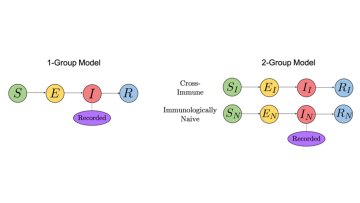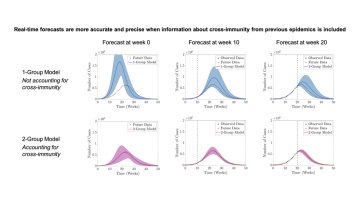16:00
The statistical mechanics of near-extremal and near-BPS black holes
Abstract
An important open question in black hole thermodynamics is about the existence of a "mass gap" between an extremal black hole and the lightest near-extremal state within a sector of fixed charge. In this talk, I will discuss how to reliably compute the partition function of 4d Reissner-Nordstrom near-extremal black holes at temperature scales comparable to the conjectured gap. I will show that the density of states at fixed charge does not exhibit a gap in the simplest gravitational non-supersymmetric theories; rather, at the expected gap energy scale, we see a continuum of states whose meaning we will extensively discuss. Finally, I will present a similar computation for nearly-BPS black holes in 4d N=2 supergravity. As opposed to their non-supersymmetric counterparts, such black holes do in fact exhibit a gap consistent with various string theory predictions.
Discrete-time signatures and randomness in reservoir computing (joint work with Christa Cuchiero, Lukas Gonon, Lyudmila Grigoryeva, Juan-Pablo Ortega)
Abstract
A new explanation of geometric nature of the reservoir computing phenomenon is presented. Reservoir computing is understood in the literature as the possibility of approximating input/output systems with randomly chosen recurrent neural systems and a trained linear readout layer. Light is shed on this phenomenon by constructing what is called strongly universal reservoir systems as random projections of a family of state-space systems that generate Volterra series expansions. This procedure yields a state-affine reservoir system with randomly generated coefficients in a dimension that is logarithmically reduced with respect to the original system. This reservoir system is able to approximate any element in the fading memory filters class just by training a different linear readout for each different filter. Explicit expressions for the probability distributions needed in the generation of the projected reservoir system are stated and bounds for the committed approximation error are provided.
Machine Learning for Partial Differential Equations
Abstract
Our understanding and ability to compute the solutions to nonlinear partial differential equations has been strongly curtailed by our inability to effectively parameterize the inertial manifold of their solutions. I will discuss our ongoing efforts for using machine learning to advance the state of the art, both for developing a qualitative understanding of "turbulent" solutions and for efficient computational approaches. We aim to learn parameterizations of the solutions that give more insight into the dynamics and/or increase computational efficiency. I will discuss our recent work using machine learning to develop models of the small scale behavior of spatio-temporal complex solutions, with the goal of maintaining accuracy albeit at a highly reduced computational cost relative to a full simulation. References: https://www.pnas.org/content/116/31/15344 and https://arxiv.org/pdf/2102.01010.pdf
From one extreme to another: the statistics of extreme events - Jon Keating
Oxford Mathematics Public Lecture
Tuesday 16 March 2021
5.00-6.00pm
Jon Keating will discuss the statistics of rare, extreme events in various contexts, including: evaluating performance at the Olympics; explaining how glasses freeze; illustrating why computers are more effective than expected at learning; and understanding the Riemann zeta-function, the mathematical object that encodes the mysterious distribution of the prime numbers.
Jon Keating is Sedleian Professor of Natural Philosophy in the University of Oxford and a Fellow of The Queen's College.
Watch live (no need to register and it will stay up afterwards):
Oxford Mathematics Twitter
Oxford Mathematics Facebook
Oxford Mathematics Livestream
Oxford Mathematics YouTube
The Oxford Mathematics Public Lectures are generously supported by XTX Markets.
16:00
Yangian Bootstrap for Massive Feynman Integrals
Abstract
In this talk I review the recent discovery of Yangian symmetry for massive Feynman integrals and how it can be used to set up a Yangian Bootstrap. I will provide elementary proofs of the symmetry at one and two loops, whereas at generic loop order I conjecture that all graphs cut from regular tilings of the plane with massive propagators on the boundary enjoy the symmetry. After demonstrating how the symmetry may be used to constrain the functional form of Feynman integrals on explicit examples, I comment on how a subset of the diagrams for which the symmetry is conjectured to hold is naturally embedded in a Massive Fishnet theory that descends from gamma-deformed Coulomb branch N=4 Super-Yang-Mills theory in a particular double scaling limit.
Fusion Systems and Rank 2 Amalgams
Abstract
Saturated fusion systems capture and abstract conjugacy in $p$-subgroups of finite groups and have recently found application in finite group theory, representation theory and algebraic topology. In this talk, we describe a situation in which we may identify a rank $2$ amalgam within $\mathcal{F}$ and, using some local group theoretic techniques, completely determine $\mathcal{F}$ up to isomorphism.
14:00
The scaling limit of a critical random directed graph
Part of the Oxford Discrete Maths and Probability Seminar, held via Zoom. Please see the seminar website for details.
Abstract
We consider the random directed graph $D(n,p)$ with vertex set $\{1,2,…,n\}$ in which each of the $n(n-1)$ possible directed edges is present independently with probability $p$. We are interested in the strongly connected components of this directed graph. A phase transition for the emergence of a giant strongly connected component is known to occur at $p = 1/n$, with critical window $p = 1/n + \lambda n-4/3$ for $\lambda \in \mathbb{R}$. We show that, within this critical window, the strongly connected components of $D(n,p)$, ranked in decreasing order of size and rescaled by $n-1/3$, converge in distribution to a sequence $(C_1,C_2,\ldots)$ of finite strongly connected directed multigraphs with edge lengths which are either 3-regular or loops. The convergence occurs in the sense of an $L^1$ sequence metric for which two directed multigraphs are close if there are compatible isomorphisms between their vertex and edge sets which roughly preserve the edge lengths. Our proofs rely on a depth-first exploration of the graph which enables us to relate the strongly connected components to a particular spanning forest of the undirected Erdős-Rényi random graph $G(n,p)$, whose scaling limit is well understood. We show that the limiting sequence $(C_1,C_2,\ldots)$ contains only finitely many components which are not loops. If we ignore the edge lengths, any fixed finite sequence of 3-regular strongly connected directed multigraphs occurs with positive probability.



